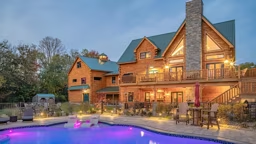
Think ahead before breaking ground and you can avoid costly mistakes. Here are 4 tips to help you build a better log home, plus a bit of info about how to save your property's trees during construction.
Properly orient your home on your building lot.
To build a better log home, consider not only how each room takes in views, but also the sun’s path and prevailing winds. Also, make sure the location of your well and septic system doesn’t prevent you from making home improvements. If you wish later on to put an addition onto the building, for example, you may not be able to because the well and septic locations block the way.
Keep all the trees you can.
Trees can provide shade and a whole lot more. Deciduous trees to the south will shield your home in the summer and, once they lose their leaves, expose more sun during winter’s shorter days. A south exposure can be wonderful in northern climes, where homes can use extra sunlight during cold winters. A windbreak of pine trees can shield a home from driving winds, especially important if your home sits on a mountaintop or ridge.
Consider window placement.
Though windows let in light and provide view opportunities, they can also rob your home of energy because they replace a log wall’s natural insulation with glass, which has less insulation than solid wood. On the other hand, a wall of windows that constantly faces the sun can bring in too much heat.
Incorporate dormers into your design.
Adding dormers can increase space in upstairs rooms, especially in homes with shallow roof pitches, but be sure you weatherproof your dormers with adequate flashing and design them to divert water away from the structure. Log dormers can be difficult to maintain. The log corners can easily trap and retain water and snow against the log work, keeping it constantly saturated. Using a framed dormer with siding is could be a better option than whole-log construction. Shingles, board and batten, and clapboard are great dormer materials that add more interest and added texture to the home’s character. But keep in mind that homes with many corners and roof angles increase energy demands and create more possibilities of ice damming or roof leaks than do roof systems with more straight lines.
Show Trees Some Love
The joy of building on property with mature trees is diminished if a significant number of these trees are lost during and after construction. The Arbor Day Foundation advises increasing their chances of survival by being aware of how trees grow, especially under the ground. Then, by marking and protecting trees during construction, you’ll enjoy beautiful, healthy trees in the years after.
Carefully site buildings, roads and driveways, utility lines and other features so that they avoid the trees you most want to save. Follow these steps:
- Design to save trees. A plat of your property, show the location of trees that matter most to you. Consider these trees in deciding the location of the house, garage, driveway, walks, patio and other features. Stake out the location of these improvements to give you a better idea how they will affect the trees when they are built. Sometimes changing the angle of a building or curving a walk can preserve the root space of a prized tree.
- Mark and fence trees. Be sure trees are clearly marked and your desires are clearly communicated to contractors. Build temporary fences of brightly colored or flagged material so that construction workers can clearly see zones from which equipment must be kept clear.
- Protect trees during construction. Cutting into the tree’s roots, compacting the soil over roots, or changing the ground level around a tree during construction are three of the most common causes of tree damage or death. Modern construction equipment can quickly damage tree bark or compact soil to the point where your prized trees’ roots are starved of oxygen and moisture. Make sure that no equipment operates within the drip lines (edges of the canopy) of trees you wish to save.
- Keep the ground around trees on the level. Lowering the grade can sever roots. A stone well can help keep soil near the trunk at the original level. For fill beyond the well, use only light, porous, gravelly soil out to the tree’s drip line, never exceeding 6 inches in depth. A tree’s roots can extend far beyond the limits of its canopy. If a change in grade is necessary, build a retaining wall at a distance where you can save as many of the roots as possible.











